Build Better Workflows

Do you experience any of the following challenges:
- You lack process documentation.
- Your documentation lacks flowchart examples.
- Your workflows have points of friction and need improvement.
Our Advice
Critical Insight
- Don’t just document – target your future state as you document your workflows.
- Find opportunities for automation, pinpoint key handoff points, and turn cold handoffs into warm handoffs
Impact and Result
- Understand the basics of documenting a workflow in flowchart format.
- Run activities to revise and stress-test your workflows to improve their accuracy and effectiveness.
- Ensure your workflows are part of a continuous improvement cycle – keep them up to date as a living document.
Build Better Workflows Research & Tools
Besides the small introduction, subscribers and consulting clients within this management domain have access to:
1. Build Better Workflows – A step by step document that walks you through the process of convening a working group to design and update a process flowchart.
Ask the right questions and pressure test the workflow so the documentation is as helpful as possible to all who consult it.
- Build Better Workflows Storyboard
2. Workflow Activity: An onboarding example for a completed flowchart review.
Use this workflow as an example of the output of an onboarding workflow-improvement activity.
- Workflow Activity: Onboarding Example (Visio)
- Workflow Activity: Onboarding Example (PDF)
Further reading
Build Better Workflows
Go beyond draft one to refine and pressure test your process.
Analyst Perspective
Remove friction as you document workflows

Emily Sugerman Info-Tech Research Group |
You can’t mature processes without also documenting them. Process documentation is most effective when workflows are both written out and also visualized in the form of flow charts. Your workflows may appear in standard operating procedures, in business continuity and disaster recovery plans, or anywhere else a process’ steps need to be made explicit. Often, just getting something down on paper is a win. However, the best workflows usually do not emerge fully-formed out of a first draft. Your workflow documentation must achieve two things:
This research will use the example of improving an onboarding workflow. Ask the right questions and pressure test the workflow so the documentation is as helpful as possible to all who consult it. |
Executive Summary
Your Challenge |
Common Obstacles |
Info-Tech’s Approach |
|---|---|---|
|
|
Use this material to help
|
Info-Tech Insight
Don’t just document – target your future state as you document your workflows. Find opportunities for automation, pinpoint key handoff points, and turn cold handoffs into warm handoffs.
Follow these steps to build, analyze, and improve the workflow
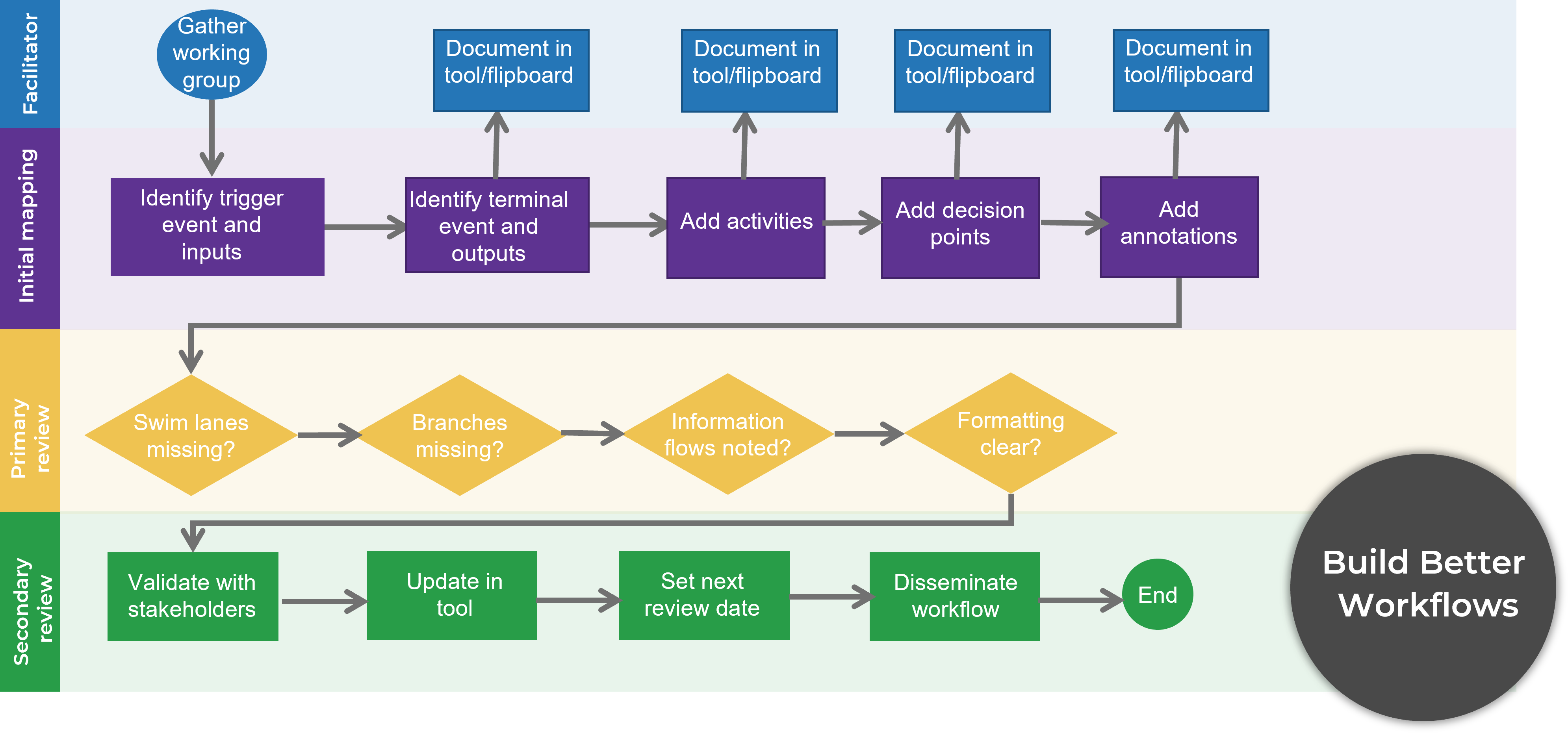
Insight Summary
Keep future state in mind.
Don’t just document – target your future state as you document your workflows. Find opportunities for automation, pinpoint key handoff points, and turn cold handoffs into warm handoffs.
Promote the benefits of documenting workflows as flowcharts.
Foreground to the IT team how this will improve customer experience. End-users will benefit from more efficient workflows.
Remember the principle of constructive criticism.
Don’t be afraid to critique the workflow but remember this can be a team-building experience. Focus on how these changes will be mutually beneficial, not assigning blame for workflow friction.
Don’t waste time building shelfware.
Establish a review cadence to ensure the flowchart is a living document that people actually use.
Benefits of building better workflows
Risks of inadequate workflows |
Benefits of documented workflows |
|---|---|
|
|
Why are visualized workflows useful?
Use these talking points to build commitment toward documenting/updating processes.
Risk reduction
“Our outdated documentation is a risk, as people will assume the documented process is accurate.”
Transparency
“The activity of mapping our processes will bring transparency to everyone involved.”
Accountability
“Flow charts will help us clarify task ownership at a glance.”
Accessibility
“Some team members prefer diagrams over written steps, so we should provide both.”
Knowledge centralization
“Our flow charts will include links to other supporting documentation (checklists, vendor documentation, other flowcharts).”
Role clarification
“Separating steps into swim lanes can clarify different tiers, process stages, and ownership, while breaking down silos.”
Communication
To leadership/upper management: “This process flow chart quickly depicts the big picture.”
Knowledge transfer
“Flow charts will help bring new staff up to speed more quickly.”
Consistency
“Documenting a process standardizes it and enables everyone to do it in the same way.”
Review what process mapping is
A pictorial representation of a process that is used to achieve transparency.
This research will use one specific example of an onboarding process workflow. Before drilling down into onboarding workflows specifically, review Info-Tech’s Process Mapping Guide for general guidance on what to do before you begin:
- Know the purpose of process mapping.
- Articulate the benefits of process mapping.
- Recognize the risks of not process mapping.
- Understand the different levels of processes.
- Adopt BPMN 2.0 as a standard.
- Consider tools for process mapping.
- Select a process to map.
- Learn methods to gather information.
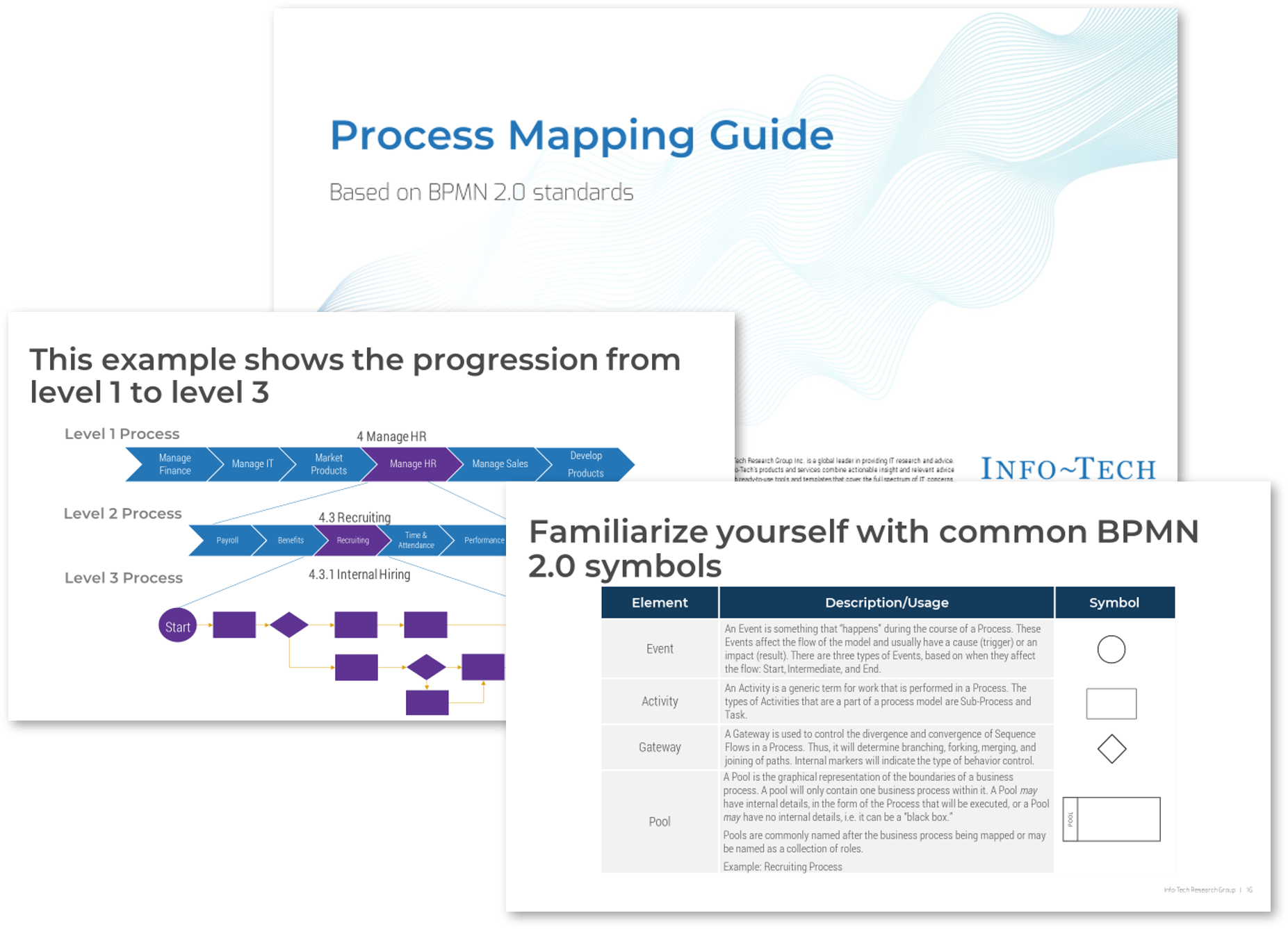
Download the Process Mapping Guide
Select the workflow your team will focus upon
Good candidates include:
- Processes you don’t have documented and need to build from scratch.
- An existing process that results in an output your users are currently dissatisfied with (if you run an annual IT satisfaction survey, use this data to find this information).
- An existing process that is overly manual, lacks automation, and causes work slowdown for your staff.
Info-Tech workflow examples
Application Development Process
Application Maintenance Process
Business Continuity Plan Business Process
Business Continuity Plan Recovery Process
Commitment Purchasing Workflow
Coordinated Vulnerability Disclosure Process
Data Protection Recovery Workflow
Disaster Recovery Plan/Business Continuity Plan Review Workflow
End-User Device Management Workflow Library
Incident Management and Service Desk Workflows
Security Policy Exception Process
Self-Service Resolution Process
Service Desk Ticket Intake by Channel
Example: Onboarding workflow
Onboarding is a perennial challenge due to the large number of separate teams and departments who are implicated in the process.
There can be resistance to alignment. As a result, everyone needs to be pulled in to see the big picture and the impact of an overly manual and disconnected process.
Additionally, the quality of the overall onboarding process (of which IT is but one part) has a significant impact on the employee experience of new hires, and the long-term experience of those employees. This workflow is therefore often a good one to target for improvement.
“Organizations with a standardized onboarding process experience 62% greater new hire productivity, along with 50% greater new hire retention.”1
“Companies that focus on onboarding retain 50% more new employees than companies that don’t.”2
1. Carucci, “To Retain New Hires, Spend More Time Onboarding Them,” 2018
2. Uzialko, “What Does Poor Onboarding, 2023
Tabletop exercise: Generate first draft
In the tabletop exercise, your team will walk through your onboarding process step by step and document what happens at each stage. Prep for this meeting with the following steps:
- Identify roles: facilitator, notetaker, and participants. Determine who should be involved in the working group in addition to IT (HR, Hiring Team, Facilities, etc.).
- Decide what method of documentation you will use in the meeting. If meeting in person, cue cards are useful because they can be easily rearranged or inserted. If meeting remotely, the notetaker or facilitator will need to share their screen and capture each step with software (such as Visio, PowerPoint, or a whiteboarding software).
- Before you even begin mapping out the process, conduct a quick brainstorming session. What are your current challenges with it? What is working? Document on a whiteboard (electronic or hard copy).
- Document each step of the process as it currently happens. You will improve it later. Include task ownership.
Roles
Facilitator
Tasks:
- Guide discussion – restate contributors’ ideas, ask probing questions.
- Keep group on track – cut off or redirect conversation when off track.
Notetaker
Tasks:
- Ensure the steps are documented via the agreed-upon tools (e.g. cue cards). If the process is being documented in software, the notetaker may be solely responsible for documentation.
- The notetaker may be the same person as the facilitator.
Document your workflow challenges: Onboarding
Brainstorm and document. Group similar challenges together to pull out themes.
Lack of communication/expectation setting with users: |
Messy process, poor coordination among task owners: |
User experience affected: |
|---|---|---|
|
|
|
Establish flowcharting standards
If you don’t have existing flowchart standards, use the basic notation conventions used in the examples here.
 |
Start, End, and Connector. Traditional flowcharting standards reserve this shape for connectors to other flowcharts or other points in the existing flowchart. Unified modeling language (UML) also uses the circle for start and end points. Start, End. Traditional flowcharting standards use this for start and end. However, Info-Tech recommends using the circle shape to reduce the number of shapes and avoid confusion with other similar shapes. Process Step. Individual process steps or activities (e.g. create ticket or escalate ticket). If it’s a series of steps, then use the sub-process symbol and flowchart the sub-process separately. Sub-Process. A series of steps. For example, a critical incident standard operating procedure (SOP) might reference a recovery process as one of the possible actions. Marking it as a sub-process, rather than listing each step within the critical incident SOP, streamlines the flowchart and avoids overlap with other flowcharts (e.g. the recovery process). Decision. Represents decision points, typically with yes/no branches, but you could have other branches depending on the question (e.g. a “Priority” question could branch into separate streams for Priority 1, 2, 3, 4, and 5 issues). Document/Report Output. For example, the output from a backup process might include an error log. |
Map the current process
Prompt the working group with the following questions.
- What happens when the ticket comes in? Who submits it? Where is it coming from? What are the trigger events? Are there any input channels we should eliminate?
- What is the terminal event? Where does the workflow end?
- Do we have a triage step?
- Is the ticket prioritized? Does this need to be a step?
- Do we create child tickets? Separate tasks for different teams? Do we create a primary/main ticket and sub-tickets? How should we represent this in the flowchart?
- How should we represent escalations? How should we represent task ownership by different teams?
- What are our decision points: points when the path can potentially branch (e.g. into yes/no branches)?
Map the process: First pass
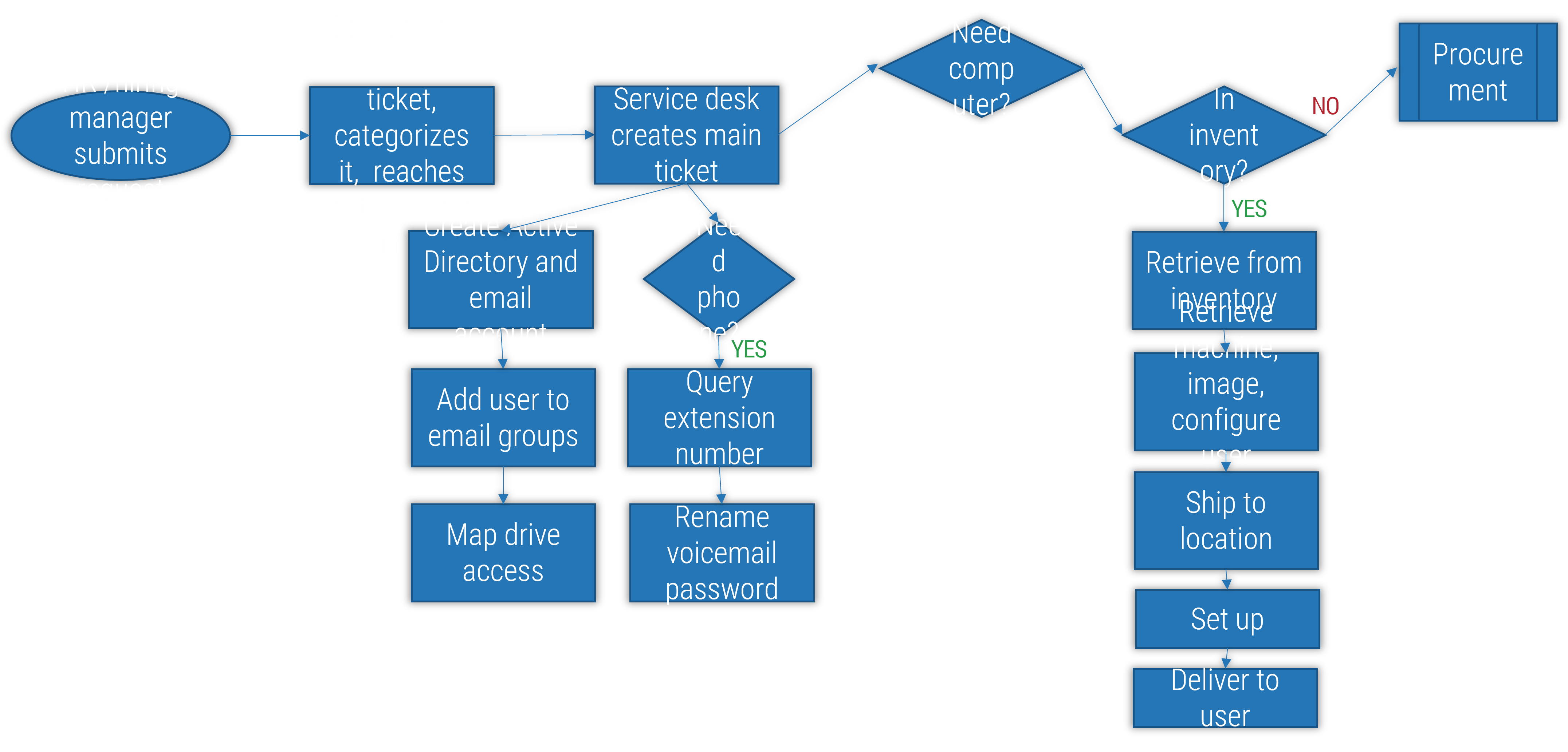
Tabletop exercise: Revise workflow
Time to review and revise the workflow. What gaps exist? How can you improve the process? What documentation gaps have been overlooked?
Consider the following refinements for the onboarding workflow:
- Identify missing steps
- Clearly identify task ownership
- Establish SLAs and timepoints
- Capture/implement user feedback
- Identify approval roadblocks
- Identify communication points
- Identify opportunities for automation
- Create personas
- Create onboarding checklist
Roles
Facilitator
Tasks:
- Guide discussion – restate contributors’ ideas, ask probing questions.
- Keep group on track – cut off or redirect conversation when off track.
Notetaker
Tasks:
- Ensure the steps are documented via the agreed-upon tools (e.g. cue cards). If the process is being documented in software, the notetaker may be solely responsible for documentation.
- The notetaker may be the same person as the facilitator, but this takes some practice.
Map the process: Critique draft
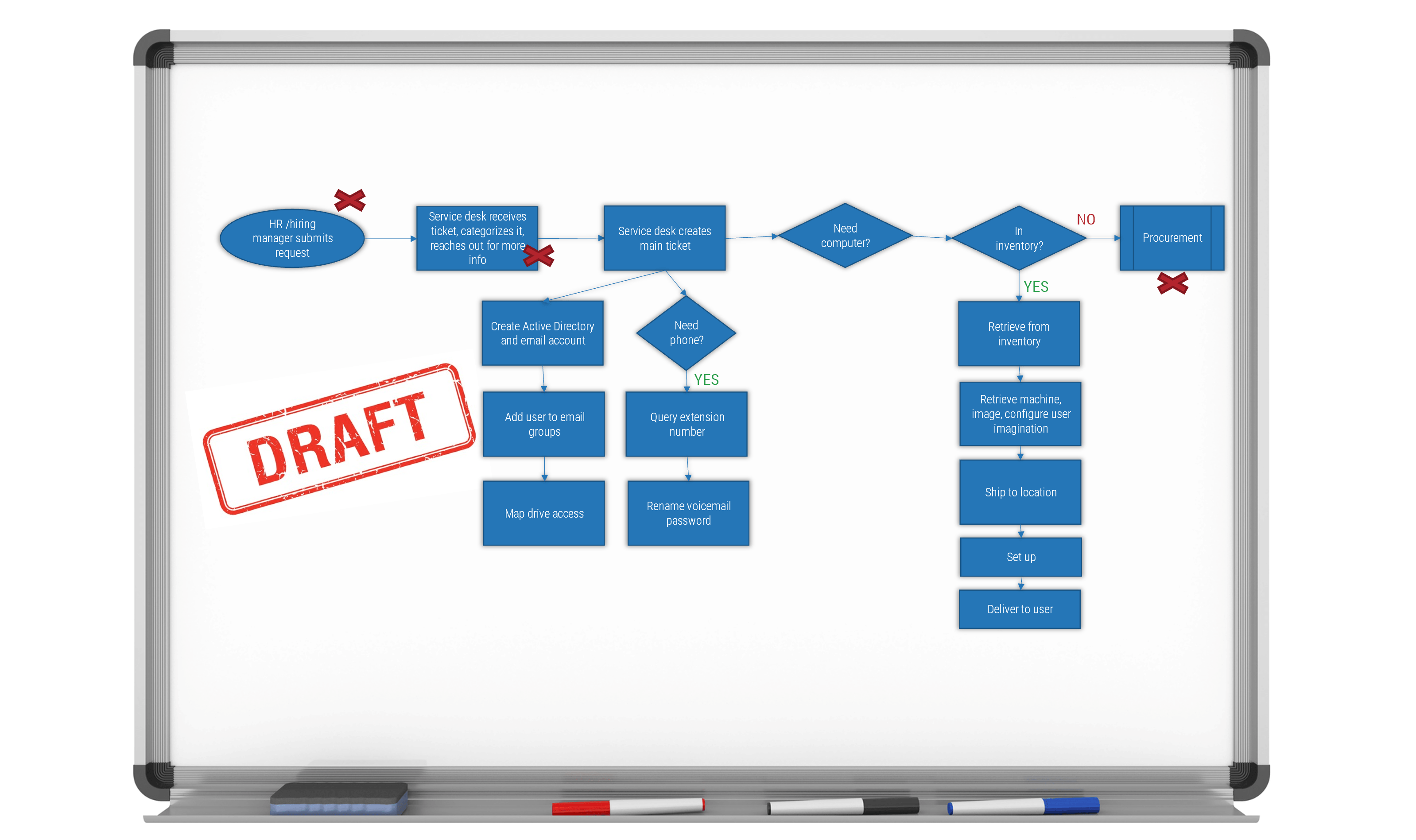
Solicit feedback from the group.
"
- Our workflow is slowed down by hidden approvals that we haven’t mapped.
- We have no efficient way to prevent submission of incomplete requests.
- Our workflow doesn’t clearly show how different tasks are assigned to different teams.
- We still don’t know how long this all takes.
- We’re missing some tasks – what about including facilities?
- We’re missing next steps for some of the decision points.
Review: Identify missing steps
Consider the following refinements.
Be complete.
The workflow should surface tacit knowledge, so make it explicit (Haddadpoor et al.):
- Where are the inputs coming from? Do you need to account for various input channels? Have you forgotten any?
- Are there any input channels that you want to eliminate?
- Have you overlooked any hardware, software, or services entitlements that should be called out?
- Have all decision paths been worked through? Do you need to add any missing decision points?
- Add information flows and annotations as needed.
Review: Task ownership
Identify task ownership.
The flow chart will be more useful if it clearly identifies who does what in the process.
- Consider organizing the sub-processes within the overall onboarding process into swim lanes, one for each team or group involved in the process.
- Swim lanes help clarify who does what in the overall process (e.g. all the tasks completed by HR appear in the HR swim lane, all the tasks completed by service desk appear in the service desk swim lane).
- They can also help draw attention to escalation points or handoff points between different teams. Assess the steps around the boundary of each swim lane. Does the working group experience/know of friction at these handoff points? What might solve it?
- In what order should the tasks occur? What dependencies do they have?
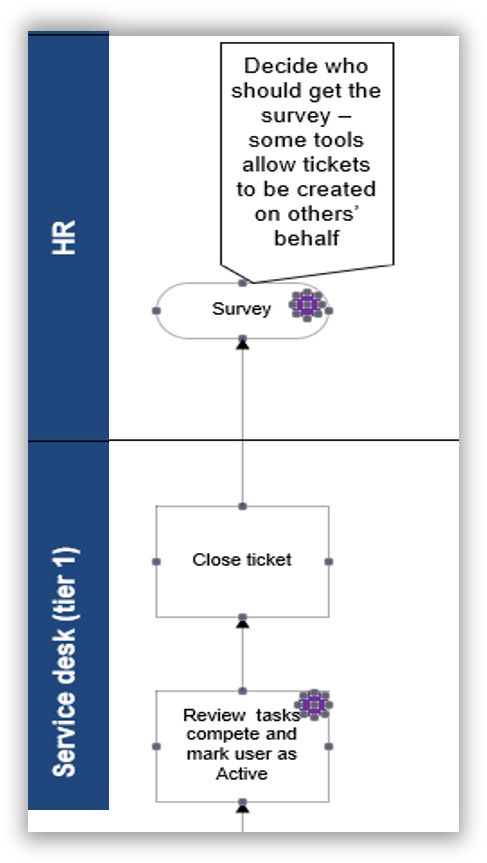
“Each task has an owner, and the task list is visible to the employee and other stakeholders, so there's visibility about whether each person has done their actions.”
Matthew Stibbe, qtd. in Zapier, 2022
Review: The time the workflow takes
For onboarding, this means setting SLOs/SLAs and internal timepoints.
Add internal timepoints for the major steps/tasks in the workflow. Begin to track these service level objectives and adjust as necessary.
- Review old onboarding tickets and track how long each main step/task takes (or should take). Every additional approval risks adding days.
- Consider where there are opportunities to increase automation or use templates to save time.
- Zero in on which task within the onboarding workflow is slowing down the process.
- Create an overall service level objective that communicates how many days the onboarding workflow is expected to take. Decide where escalations go when the SLA is breached.
When you have validated the service level objectives are accurate and you can meet them an acceptable amount of time, communicate the overall SLA to your users. This will ensure they submit future onboarding requests to your team with enough lead time to fulfill the request. Try to place the SLA directly in the service catalog.
“Tracking the time within the workflow can be a powerful way to show the working group why there is user dissatisfaction.”
Sandi Conrad, Principal Advisory Director, Info-Tech Research Group
Review: Capture user feedback
For onboarding, this means implementing a transactional survey.
The onboarding workflow will be subject to periodic reviews and continual improvement. Suggestions for improvement should come not only from the internal IT team, but also the users themselves.
- Transactional surveys, launched at the close of a ticket, allow the ticket submitter to provide feedback on their customer service experience.
- Onboarding tickets are somewhat more complex than the average incident or service request, since the ticket is often opened by one user (e.g. in HR) on behalf of another (the new employee).
- Decide whose experience you want feedback on – the submitter of the request or the new user. Investigate your ITSM tool’s capabilities: is it possible to direct the survey to someone who is not the ticket submitter?
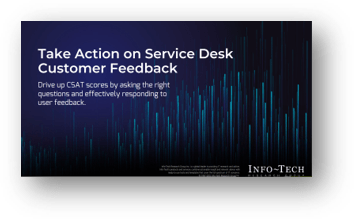
Use Info-Tech’s Take Action on Service Desk Customer Feedback for more guidance on creating these surveys.
Review: Identify approval roadblocks
For onboarding, approvals can be the main roadblock to fulfilling requests
- How are the requests coming in? Do we have a predefined service catalog?
- What kinds of approvals do we receive (manager, financial, legal, security, regulatory)? Ask the team to think about where there are instances of back and forth and clean that up.
- Identify where approvals interrupt the technical flow.
- Confirm that these approvals are indeed necessary (e.g. are certain approval requests ever declined? If not, follow up on whether they are necessary or whether some can be made into preapprovals).
- Avoid putting agents in charge of waiting on or following up about approvals.
- Investigate whether interruptive approvals can be moved.
Review: Identify communication points
A positive onboarding experience is an important part of a new employee’s success.
Though IT is only one part of an employee’s onboarding experience, it’s an important part. Delays for hardware procurement and a lack of communication can lead to employee disengagement. Ask the team:
- Are we communicating with our users when delays occur? When do delays occur most often?
- How can we mitigate delays? Though we can’t resolve larger supply chain problems, can we increase stock in the meantime?
- Can we start tracking delays to incorporate into the SLA
- Do we offer loaner devices in the meantime?
Place communication bullet points in the flow chart to indicate where the team will reach out to users to update or notify them of delays.
Review: Identify opportunities for automation
Where can we automate for onboarding?
Identify when the process is dragged out due to waiting times (e.g. times when the technician can’t address the ticket right away).
- Analyze the workflow to identify which tasks tend to stagnate because technician is busy elsewhere. Are these candidates for automation?
- Is our ITSM tool capable of setting up automatically routed child tickets triggered by the main onboarding ticket? Does it generate a series of tasks? Is it a manual process? Which teams do these tasks/tickets go to?
- Can we automate notifications if devices are delayed?
- Can we use mobile device management for automated software installation?
- If we have a robust service catalog, can we provide it to the users to download what they need? Or is this too many extra steps for our users?
- Can we create personas to speed up onboarding?
Avoid reinforcing manual processes, which make it even harder for departmental silos to work together.
Review: Automation example – create personas
Create role-based templates.
Does HR know which applications our users need? Are they deferring to the manager, who then asks IT to simply duplicate an existing user?
Personas are asset profiles that apply to multiple users (e.g. in a department) and that can be easily duplicated for new hires. You might create three persona groups in a department, with variations within each subgroup or title. To do this, you need accurate information upfront.
Then, if you’re doing zero touch deployment, you can automate software to automatically load.
Many HRIS systems have the ability to create a persona, and also to add users to the AD, email, and distribution groups without IT getting involved. This can alleviate work from the sysadmin. Does our HRIS do this?
- Review old onboarding tickets. Do they include manual steps like setting up mailboxes, creating user accounts, adding to groups?
- Investigate your ITSM tool’s onboarding template. Does it allow you to create a form through which to create dynamic required fields?
- Identify the key information service desk needs from the department supervisor, or equivalent role, to begin the onboarding request – employee type, access level, hardware and software entitlements, etc.
Revised workflow
How does the group feel about the revised workflow?
- Are any outputs still missing?
- Can we add any more annotations to provide more context to someone reading this for the first time?
- Do the task names follow a “verb-noun” format?
- Are the handoffs clear?
- Are some of the steps overly detailed compared to others?
- Does it help resolve the challenges we listed?
- Does it achieve the benefits we want to achieve?
Download the Workflow Activity: Onboarding Example
Remember the principle of constructive criticism.
Don’t be afraid to critique the workflow but remember this can also be a team-building experience. Focus on how these changes will be mutually beneficial, not assigning blame for workflow friction.
Post-review: Revised workflow
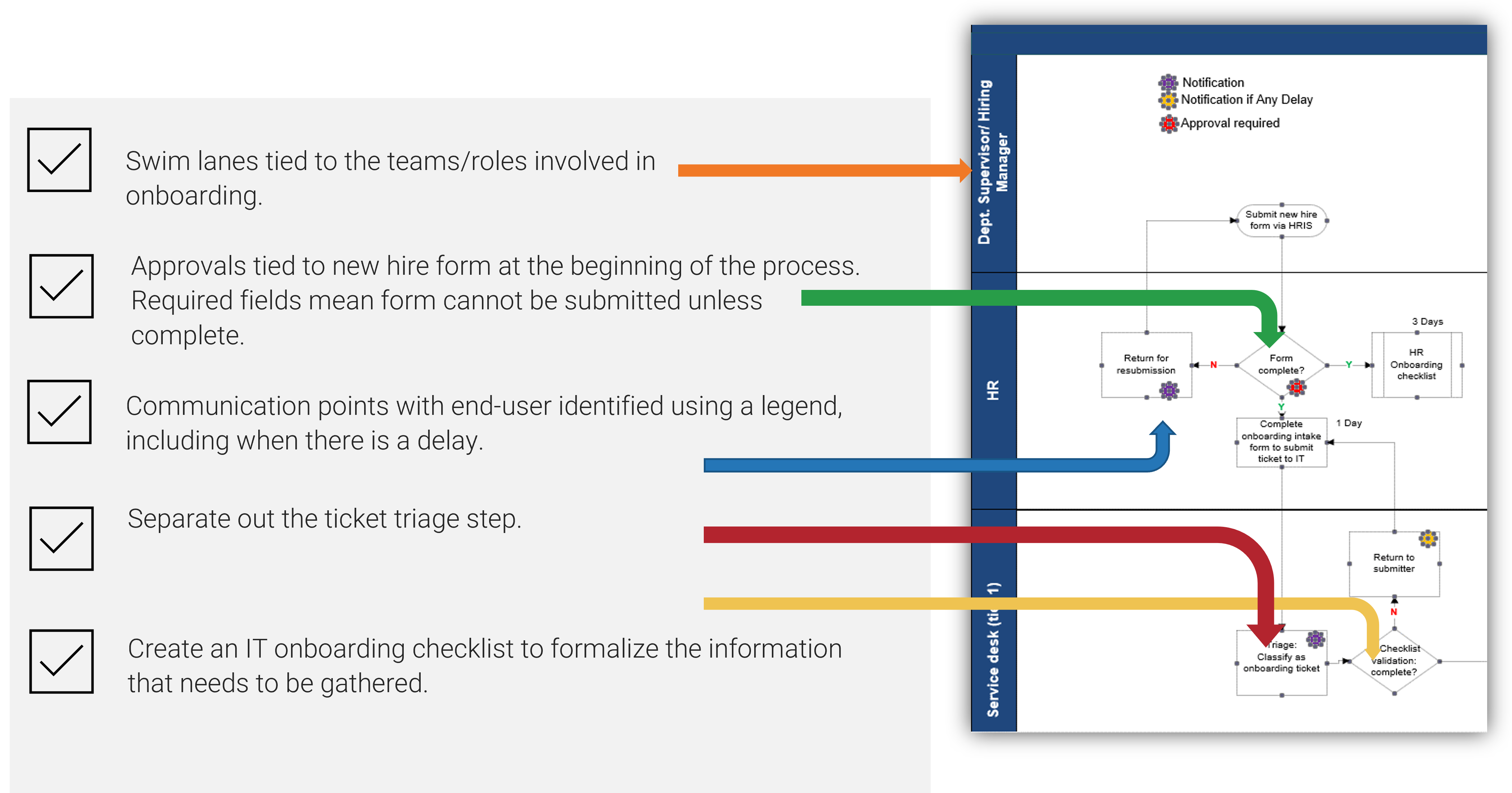
Final check
- Do we need to run this by Legal?
- Have we included too many sub-processes? Not enough?
- Is the flowchart easy to read and follow?
Decide how often this workflow will be revised.
- Is this workflow part of a larger piece of documentation that has a set review cadence? Where is it stored?
- If not, what is a realistic time frame for regular review?
- Who will own this process in an ongoing way and be in charge of convening a future review working group?
Validation with stakeholders
- What documentation does the flowchart belong to? When will you review it again?
- Who do you need to validate the flowchart with?
Share the flowchart and set up a review meeting.
- Walk through the workflow with stakeholders who did not participate in building it.
- Do they find it easy to follow?
- Can they identify missing steps?
Don’t waste time building shelfware.
Establish a review cadence to ensure the flowchart is a living document that people actually use.
Info-Tech offers various levels of support to best suit your needs
DIY Toolkit
“Our team has already made this critical project a priority, and we have the time and capability, but some guidance along the way would be helpful.”
Guided Implementation
“Our team knows that we need to fix a process, but we need assistance to determine where to focus. Some check-ins along the way would help keep us on track.”
Workshop
“We need to hit the ground running and get this project kicked off immediately. Our team has the ability to take this over once we get a framework and strategy in place.”
Consulting
“Our team does not have the time or the knowledge to take this project on. We need assistance through the entirety of this project.”
Diagnostics and consistent frameworks used throughout all four options
Bibliography
Bushkill, Claire. “The top 5 ways to automate your onboarding checklist.” Rippling Blog. 18 Mar 2022. Accessed 29 Nov 2022. Ha https://www.rippling.com/blog/the-top-5-ways-to-automate-your-onboarding-checklist
Carucci, Ron. “To Retain New Hires, Spend More Time Onboarding Them.” Harvard Business Review, 3 Dec 2018
Haddadpoor, Asefeh, et al. “Process Documentation: A Model for Knowledge Management in Organizations.” Materia Socio-Medica, vol. 27, no. 5, Oct. 2015, pp. 347–50. PubMed Central, https://doi.org/10.5455/msm.2015.27.347-350.
King, Melissa. “New hire checklist: An employee onboarding checklist template for 2022.” Zapier. 14 Jul 2022. Accessed 29 Nov 2022. https://zapier.com/blog/onboarding-checklist/
Uzialko, Adam. “What Does Poor Onboarding Really Do to Your Team?” Business News Daily. 23 Jan 2023.
https://www.manageengine.com/products/service-desk...
Contributors
Sandi Conrad, Principal Advisory Director, Infrastructure and Operations, Info-Tech Research Group
Christine Coz, Executive Counselor, Info-Tech Research Group
Allison Kinnaird, Practice Lead, Infrastructure and Operations, Info-Tech Research Group
Natalie Sansone, Research Director, Infrastructure and Operations, Info-Tech Research Group
Buying Options
Build Better Workflows
IT Risk Management · IT Leadership & Strategy implementation · Operational Management · Service Delivery · Organizational Management · Process Improvements · ITIL, CORM, Agile · Cost Control · Business Process Analysis · Technology Development · Project Implementation · International Coordination · In & Outsourcing · Customer Care · Multilingual: Dutch, English, French, German, Japanese · Entrepreneur
Tymans Group is a brand by Gert Taeymans BV
Gert Taeymans bv
Europe: Koning Albertstraat 136, 2070 Burcht, Belgium — VAT No: BE0685.974.694 — phone: +32 (0) 468.142.754
USA: 4023 KENNETT PIKE, SUITE 751, GREENVILLE, DE 19807 — Phone: 1-917-473-8669
Copyright 2017-2022 Gert Taeymans BV